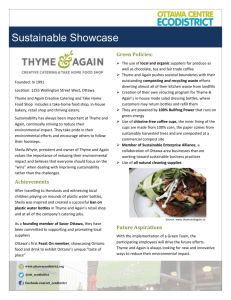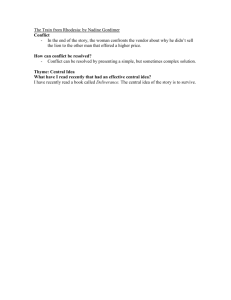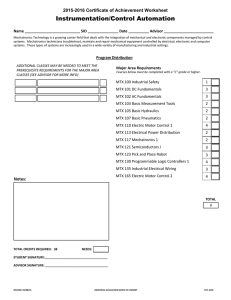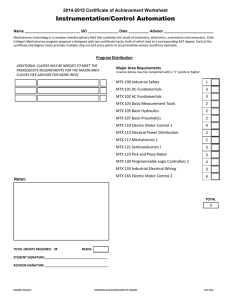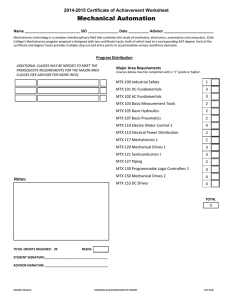Document 13310152
advertisement
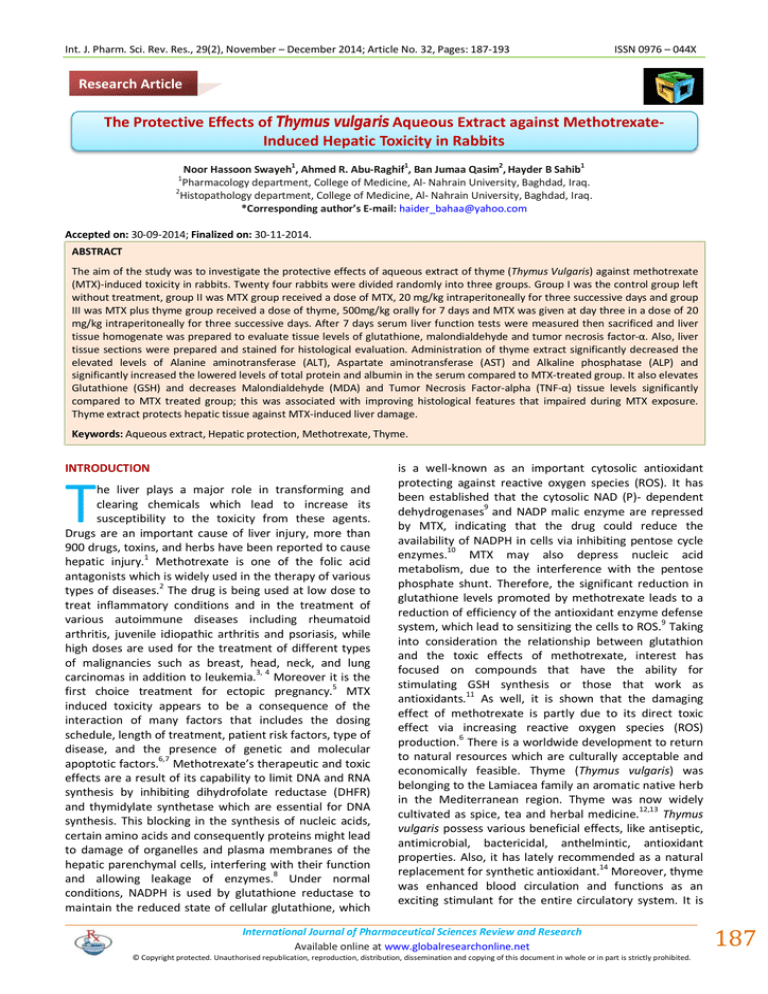
Int. J. Pharm. Sci. Rev. Res., 29(2), November – December 2014; Article No. 32, Pages: 187-193 ISSN 0976 – 044X Research Article The Protective Effects of Thymus vulgaris Aqueous Extract against MethotrexateInduced Hepatic Toxicity in Rabbits 1 1 2 1 Noor Hassoon Swayeh , Ahmed R. Abu-Raghif , Ban Jumaa Qasim , Hayder B Sahib Pharmacology department, College of Medicine, Al- Nahrain University, Baghdad, Iraq. 2 Histopathology department, College of Medicine, Al- Nahrain University, Baghdad, Iraq. *Corresponding author’s E-mail: haider_bahaa@yahoo.com 1 Accepted on: 30-09-2014; Finalized on: 30-11-2014. ABSTRACT The aim of the study was to investigate the protective effects of aqueous extract of thyme (Thymus Vulgaris) against methotrexate (MTX)-induced toxicity in rabbits. Twenty four rabbits were divided randomly into three groups. Group I was the control group left without treatment, group II was MTX group received a dose of MTX, 20 mg/kg intraperitoneally for three successive days and group III was MTX plus thyme group received a dose of thyme, 500mg/kg orally for 7 days and MTX was given at day three in a dose of 20 mg/kg intraperitoneally for three successive days. After 7 days serum liver function tests were measured then sacrificed and liver tissue homogenate was prepared to evaluate tissue levels of glutathione, malondialdehyde and tumor necrosis factor-α. Also, liver tissue sections were prepared and stained for histological evaluation. Administration of thyme extract significantly decreased the elevated levels of Alanine aminotransferase (ALT), Aspartate aminotransferase (AST) and Alkaline phosphatase (ALP) and significantly increased the lowered levels of total protein and albumin in the serum compared to MTX-treated group. It also elevates Glutathione (GSH) and decreases Malondialdehyde (MDA) and Tumor Necrosis Factor-alpha (TNF-α) tissue levels significantly compared to MTX treated group; this was associated with improving histological features that impaired during MTX exposure. Thyme extract protects hepatic tissue against MTX-induced liver damage. Keywords: Aqueous extract, Hepatic protection, Methotrexate, Thyme. INTRODUCTION T he liver plays a major role in transforming and clearing chemicals which lead to increase its susceptibility to the toxicity from these agents. Drugs are an important cause of liver injury, more than 900 drugs, toxins, and herbs have been reported to cause hepatic injury.1 Methotrexate is one of the folic acid antagonists which is widely used in the therapy of various types of diseases.2 The drug is being used at low dose to treat inflammatory conditions and in the treatment of various autoimmune diseases including rheumatoid arthritis, juvenile idiopathic arthritis and psoriasis, while high doses are used for the treatment of different types of malignancies such as breast, head, neck, and lung carcinomas in addition to leukemia.3, 4 Moreover it is the first choice treatment for ectopic pregnancy.5 MTX induced toxicity appears to be a consequence of the interaction of many factors that includes the dosing schedule, length of treatment, patient risk factors, type of disease, and the presence of genetic and molecular apoptotic factors.6,7 Methotrexate’s therapeutic and toxic effects are a result of its capability to limit DNA and RNA synthesis by inhibiting dihydrofolate reductase (DHFR) and thymidylate synthetase which are essential for DNA synthesis. This blocking in the synthesis of nucleic acids, certain amino acids and consequently proteins might lead to damage of organelles and plasma membranes of the hepatic parenchymal cells, interfering with their function and allowing leakage of enzymes.8 Under normal conditions, NADPH is used by glutathione reductase to maintain the reduced state of cellular glutathione, which is a well-known as an important cytosolic antioxidant protecting against reactive oxygen species (ROS). It has been established that the cytosolic NAD (P)- dependent dehydrogenases9 and NADP malic enzyme are repressed by MTX, indicating that the drug could reduce the availability of NADPH in cells via inhibiting pentose cycle enzymes.10 MTX may also depress nucleic acid metabolism, due to the interference with the pentose phosphate shunt. Therefore, the significant reduction in glutathione levels promoted by methotrexate leads to a reduction of efficiency of the antioxidant enzyme defense system, which lead to sensitizing the cells to ROS.9 Taking into consideration the relationship between glutathion and the toxic effects of methotrexate, interest has focused on compounds that have the ability for stimulating GSH synthesis or those that work as antioxidants.11 As well, it is shown that the damaging effect of methotrexate is partly due to its direct toxic effect via increasing reactive oxygen species (ROS) production.6 There is a worldwide development to return to natural resources which are culturally acceptable and economically feasible. Thyme (Thymus vulgaris) was belonging to the Lamiacea family an aromatic native herb in the Mediterranean region. Thyme was now widely 12,13 cultivated as spice, tea and herbal medicine. Thymus vulgaris possess various beneficial effects, like antiseptic, antimicrobial, bactericidal, anthelmintic, antioxidant properties. Also, it has lately recommended as a natural replacement for synthetic antioxidant.14 Moreover, thyme was enhanced blood circulation and functions as an exciting stimulant for the entire circulatory system. It is International Journal of Pharmaceutical Sciences Review and Research Available online at www.globalresearchonline.net © Copyright protected. Unauthorised republication, reproduction, distribution, dissemination and copying of this document in whole or in part is strictly prohibited. 187 © Copyright pro Int. J. Pharm. Sci. Rev. Res., 29(2), November – December 2014; Article No. 32, Pages: 187-193 also effective in the treatment of depression and mood changes.15 The therapeutic potential of thymus vulgaris rests on its contents of flavonoids, thymol, carvacrol, eugenol and aliphatic phenols in addition to luteolin and 16,17 saponins. This study was designed to evaluate whether the toxic effects caused by administration of methotrexate could be prevented by treatment with thyme extract. MATERIALS AND METHODS Chemicals Reagent kits for assay of transaminases were purchased from BioMerieux-France, ALP assay kit was purchased from Biolabo Sa-France, total bilirubin assay kit was obtained from Randox-United Kingdom, and kits for total protein and albumin were purchased from Linear Chemicals – Spain. Reagent elisa kits for determination of tissue malondialdehyde (MDA), reduced glutathione (GSH) and tumor necrosis factor alpha (TNF-α) were purchased from Cusabio - China. The work was done in accordance with the method prescribed in each diagnostic kit. Thyme aqueous extraction ISSN 0976 – 044X rabbits were subjected to blood collection under anesthesia by ether inhalation, the blood collected directly from the heart, centrifuged to get serum which stored at -20°C for biochemical analysis. After scarification the liver tissue were excised by thoracic section, two portions was isolated one of them were fixed in 10% formalin for 24 hours and embedded in paraffin. Blocks were cut by microtome into 5 mm thick sections, and then following staining with hematoxylin-eosin (H-E) stains, sections were examined by Olympus CH-2 light microscope. The other portion was mobilized into the cooling box quickly to prevent autolysis and homogenization was done by rinsed the liver piece with chilled phosphate buffer saline (1X PBS) at 4 0C, blotted with filter paper and weighed. One gram of liver tissue was homogenized in 10 ml of (1X PBS) utilizing tissue homogenizer21 for 1 minute at 4 0C, then after two freeze thaw cycles were performed to break the cell membranes, the homogenates were centrifuged for 5 minutes at 5000 x g at 2 - 8°C. The supernatant was obtained and stored at -20°C for the assay of reduced glutathione, malondialdehyde and tumor necrosis factor alpha levels in the tissue. Histological Analysis Dried leaves of thyme (Thymus vulgaris) were purchased from local market in Baghdad-Iraq and were identified by the National Iraqi Institute for Herbs. The leaves of thyme were grounded into powder using an electrical grinder. One hundred gram of the fine-powder were subjected to extraction with 200 ml of boiling distilled water in a covered flask and left for 30 minutes. After that, the extract was cooled and filtered by means of Whatman No.1 filter paper to remove the particulate material then the filtrate was dried in a vacuum. The required doses then weighted and reconstituted in 5 ml of distilled water a minute ago before oral administration.18 Experimental Animals Score of liver damage severity was semi-quantitatively assessed using the modified Histological Activity Index ‘modified HAI’ as in the table (1) below: Statistical Analysis Statistical analysis was performed by using computer program SPSS (19). Crude data was analyzed to obtain mean and standard error of mean (SEM). Student paired t- test was used to compare between two groups. P of ≤ 0.05 was considered significant. The histological score comparison between each group were done by Chi square test.23 RESULTS All experimental protocols were approved by the Ethics Committee of the College of Medicine /AL Nahrain University. Twenty four healthy, local, domestic rabbits aged 3-4 months and weighing (600-1300) gm. of both sexes were used in this study. Before starting the study, the animals were left for 72 hours to acclimatize to the animal room conditions and were maintained on an environment of controlled temperature with a 12 hours light / dark cycle. All rabbits have free access to food and tap water. Rabbits were divided into 3 groups randomly, each group including 8 animals: Group 1 (control): Rabbits were left without treatment. Group 2 (MTX): Rabbits were given MTX injection (Ebwe, Australia) as an intraperitonial dose of (20 mg/kg)19 on day 3 of the experiment continued for three successive days. Group 3 (Thyme + MTX): Rabbits were given aqueous extract of 20 thyme in a dose of 500 mg/kg orally once daily for 7 days, and then MTX was given intraperitonially in a dose of (20 mg/kg) on day 3 of the experiment continued for three successive days. At the end of experiment, the Biochemical results are given in tables (2) and (3). Analysis of t-test revealed highly significant increase (P≤ 0.001) in the level of S. ALP, S.AST, T.MDA and T. TNF-α in +ve control group (MTX treated group) in comparison with -ve control group (untreated group). While statistically significant decrease (P ≤ 0.05) was observed in the level of S. total protein, S. total albumin in +ve control group in comparison with –ve control group. Statistically highly significant decrease (P ≤ 0.001) was observed in +ve control group in comparison with –ve control group in relation to S.GSH. The level of S.ALT show significant increase (P ≤ 0.05) in +ve control group in comparison with –ve control group. The level of S.total bilirubin shows no significant difference between both groups. The t-test analysis revealed highly significant increase (P ≤ 0.001) in the level of S. total protein in Gp3 in comparison with Gp 2, while highly significant decrease (P ≤ 0.001) in S.ALP level was observed in Gp3 in comparison to Gp 2. Statistically there was significant increase (P ≤ 0.05) in the International Journal of Pharmaceutical Sciences Review and Research Available online at www.globalresearchonline.net © Copyright protected. Unauthorised republication, reproduction, distribution, dissemination and copying of this document in whole or in part is strictly prohibited. 188 © Copyright pro Int. J. Pharm. Sci. Rev. Res., 29(2), November – December 2014; Article No. 32, Pages: 187-193 level of S. total albumin in Gp3 when compared with Gp2, while significant decrease (P ≤ 0.05) in the level of S.ALT and S.AST were observed in Gp3 in comparison with Gp2. There was no significant difference observed in the S. total bilirubin level between the two mentioned groups. The analysis of t-test showed high significant difference increase (P ≤ 0.001) in the level of T. GSH in Gp3 in comparison to Gp2, while statistically highly significant decrease (P≤ 0.001) in the level of T.MDA and T-TNF-α were observed in Gp3 in comparison to Gp2. See table (3). Table 1: Modified Histological Activity Index – grading: 22 necroinflammatoryscores Score A. Periportal or periseptal interface hepatitis (piecemeal necrosis) ISSN 0976 – 044X Table 2: Comparison between –ve control group (Gp1) and +ve control group (Gp2) in relation to S. Total Protein, S. Total Albumin, S. Total Bilirubin, S.ALP, S. ALT, S. AST, T. GSH, T. MDA and T. TNF-α by t-test Parameter Gp1 (-ve control) (Not treated) N=8 Mean ± SD Gp2 (+ve control) (Given MTX) N=8 Mean ± SD P value S. Total Protein (g/dl) 5.63±0.91 4.28±0.47 0.0023* S. Total Albumin (g/dl) 2.63±0.35 2.1±0.21 0.0029* S. Total Bilirubin (mg/dl) 0.11±0.11 0.12±0.13 0.878 S.ALP (U/l) 59.25±6.02 128.13±22.52 < 0.0001** S. ALT (U/l) 49.25±11.02 183.75±97.54 0.0017* Absent 0 S. AST (U/l) 42.25±6.5 232.75±116.25 0.0004** Mild (focal, few portal areas) Mild\moderate (focal, most portal areas ) Moderate (continuous around<50% of tracts or septa) Severe (continuous around>50% of tracts or septa) B. Confluent necrosis 1 2 3 4 T. GSH (nmol/l) 35.76±3.6 12.33±0.63 < 0.0001** T. MDA (ng/l) 122.28±0.69 135.2±4.2 < 0.0001** T. TNF-α (pg/l) 85.53±3.73 170.89±14.8 < 0.0001** Absent Focal confluent necrosis Centrolobular necrosis in some areas Centrolobular necrosis in most areas Centrolobular necrosis +occasional portal-central(PC)bridging 0 1 2 3 Centrolobularnecrosis+ multiple P-C bridging 5 Table 3: Comparison between Gp2 (+ve control group) and Gp3 (MTX + Thyme treated group) in relation to S. Total Protein, S. Total Albumin, S. Total Bilirubin, S.ALP, S. ALT, S. AST, T. GSH, T. MDA and T. TNF-α by t-test Parameter Gp2 (MTX) (+ve control) N=8 Mean ± SD Gp3 (MTX + Thyme) N=8 Mean ± SD P value S. Total Protein (g/dl) 4.28±0.47 5.3±0.17 < 0.0001** S. Total Albumin (g/dl) 2.1±0.21 2.31±0.16 0.0392* S. Total Bilirubin (mg/dl) 0.12±0.13 0.11±0.15 0.863 S. ALP (U/l) 128.13±22.52 89.0±13.6 0.0009** 4 Panlobular or multilobular necrosis 6 C. Focal (spotty) lytic necrosis, apoptosis, and focal inflammation Absent One focus or less per 10× objective One to four foci per10× objective Five to 10 foci per 10× objective More than 10 foci per 10× objective * Denote significant difference at P ≤ 0.05 ** Denote highly significant difference at P ≤ 0.001 0 1 2 3 4 D. Protal inflammation None Mild, some or all portal areas Moderate, some or all portal areas Moderate/marked, all portal areas 0 1 2 3 S. ALT (U/l) 183.75±97.54 51.25±5.44 0.0018* S. AST (U/l) 232.75±116.25 62.0±29.74 0.0013* S. GSH (nmol/l) 12.33±0.63 26.51±3.05 < 0.0001** Marked, all portal areas Maximum possible score for grading 4 18 S. MDA (ng/l) 135.2±4.2 125.91±3.04 0.0002** S. TNF-α (pg/l) 170.89±14.8 104.7±4.81 < 0.0001** The results showed statistically significant increase (P≤ 0.05) in the histopathological scoring in Gp 2 when compared with Gp1, table (4). The histopathological examination of –ve control group (Gp 1) reveals normal hepatic tissue, no portal or periportal inflammation, necrosis and fibrosis as shown in figure (1), while there was a significant loss in hepatic architecture in +ve control group (Gp 2) which showed portal inflammation with periportal interface hepatitis (piecemeal necrosis) centrilobular necrosis and bridging necrosis see figure (2). * Denote significant difference at P ≤ 0.05 ** Denote highly significant difference at P ≤ 0.001 The results were revealed statistically significant decrease (P≤ 0.05) in the histopathological scoring in Gp3 when compared with Gp2, table (5). The histopathological examination of MTX + thyme treated group (Gp3) showed significant prevention of MTX toxic effects with moderate portal inflammation of mononuclear cells infiltrates as in figure (3). International Journal of Pharmaceutical Sciences Review and Research Available online at www.globalresearchonline.net © Copyright protected. Unauthorised republication, reproduction, distribution, dissemination and copying of this document in whole or in part is strictly prohibited. 189 © Copyright pro Int. J. Pharm. Sci. Rev. Res., 29(2), November – December 2014; Article No. 32, Pages: 187-193 Table 4: Comparison of histopathological changes (by scoring) between –ve control group (Gp1) and +ve control group –MTX treated group- (Gp2) using Chi Square. Score 0 4 5 6 8 Gp1 (- ve control) (Not treated) N=8 Gp2 (+ ve control) (Given MTX) N=8 No. % No. % 8 0 0 0 0 100 0.0 0.0 0.0 0.0 0 4 2 1 1 0.0 50.0 25.0 12.5 12.5 0.003* Table 5: Comparison of histopathological changes (by scoring) between +ve control group –MTX treated group(Gp2) and MTX+thyme treated group (Gp3) using Chi Square Score Gp3 (MTX + thyme) N=8 1 No. 0 % 0.0 No. 3 % 37.5 2 3 4 5 0 0 4 2 0.0 0.0 50.0 25.0 4 1 0 0 50.0 12.5 0.0 0.0 supported this conclusion. The results were shown that thyme extract provided significant protection from the effects of MTX on the liver. That’s results were agree with 24 other study done by Vardiand Cowarkers at 2010. P value * Denote significant difference at P ≤ 0.05 Gp2 (+control) (MTX) N=8 ISSN 0976 – 044X P value Figure 2: Sections of liver tissue of group 2 (MTX 20mg/kg) on day 8 0f the experiment shows portal inflammation with periportal interface hepatitis (piecemiel necrosis) (arrows)(on the left) and centrilobular necrosis (Cn) and bridging necrosis (Bn) (on the right). H & E stain, (40X). H:hepatocyte, Hc:hepatic cord, S:sinusoid, Pv:portal vein, Bd:bile duct, Mc:mononuclear cells infiltrate. 0.015* * Denote significant difference at P ≤ 0.05 Figure 3: Section of liver tissue of group 3 (MTX 20mg/kg+thyme extract 500mg/kg) on day 8 0f the experiment shows moderate portal inflammation of mononuclear cells infiltrates. H & E stain, (40X). H:hepatocyte, Hc:hepatic cord, S:sinusoid, Pv:portal vein, Bd:bile duct, Mc:mononuclear cells infiltrate. Figure 1: Section of liver tissue of group 1 (control group) on day 8 0f the experiment shows normal hepatic tissue, no portal or periportal inflammation, necrosis and fibrosis. H & E stain, (40X). H:hepatocyte, Hc:hepatic cord, S:sinusoid, Pv:portal vein, Bd:bile duct. DISCUSSION The results of the present study indicate that MTX lead to oxidative tissue damage by increasing lipid peroxidation and consequently inflammation in the liver tissue and decreasing the level of antioxidant enzymes. Also, increased AST, ALT and ALP with decreased levels of total protein and albumin which considered as biochemical indicators of liver damage, the histopathological findings The damage of liver tissue after MTX exposure is a wellknown phenomenon, and the clear sign of hepatic injury is the leakage of hepatic enzymes into plasma. Undoubtedly both the biochemical parameters and histological manifestations supported a diagnosis of liver damage. The elevated levels of serum enzymes of ALT, AST and ALP in MTX-treated rabbits indicate the increased permeability, damage or necrosis of hepatocytes25, these findings have been agreed withAlMotabagani,2 study which conducted on 2006 which revealed that the blocking of the synthesis of nucleic acids, certain amino acids and indirectly proteins caused by MTX toxicity might lead to damage of organelles and plasma membranes of hepatic parenchymal cells lead to interfering with their function and allowing leakage of enzymes. The decreased levels of serum total proteins were due to the disassociation of polyribosomes from International Journal of Pharmaceutical Sciences Review and Research Available online at www.globalresearchonline.net © Copyright protected. Unauthorised republication, reproduction, distribution, dissemination and copying of this document in whole or in part is strictly prohibited. 190 © Copyright pro Int. J. Pharm. Sci. Rev. Res., 29(2), November – December 2014; Article No. 32, Pages: 187-193 endoplasmic reticulum and also due to defects in protein biosynthesis26, consequently albumin levels was reduced as it represent the larger portion of serum proteins also due to increased renal loss of albumin due to the 27,28 nephrotoxicity caused by MTX, agree with this study who reported that liver disorders are related to a decrease in the serum levels of total proteins. It is well known that oxidative stress plays an important role in the tissue damage due to MTX.7,29,30 The extent of severity caused by MTX-associated liver injury was linked to both the dose and the treatment interval.29 It was established that the cytosolic nicotinamide adenosine diphosphate (NADP) dependent dehydrogenases and NADP malic enzyme were repressed by MTX, signifying that the drug could reduce the availability of NADPH (nicotinamide adenosine diphosphate hydrogen) in the cells. In the normal conditions NADPH was used by glutathione reductase to sustain the reduced state of cellular (GSH) glutathione which was an important cytosolic antioxidant. Hence, the significant lowering in glutathione (GSH) levels induced by MTX could produce a reduction of effectiveness in the antioxidant enzyme defense system and increased sensitivity of the cells to ROS.9 MDA was a stable metabolite of the free radical caused lipid peroxidation cascade.31 It is used usually as a marker of oxidative stress and destroying of lipid layers.32 As described above, methotrexate leads to lipid peroxidation via significant elevations in MDA levels. The lipid peroxidation mediated by oxygen-free radicals was thought to be an important cause of destruction and damage to the cell membranes and was suggested to be a contributing factor of the development of MTX- mediated tissue damage.31 The free-radicals were seem to trigger the accumulation of leukocytes in the tissues involved, and thus exacerbate tissue injury indirectly through the activation of neutrophils. It has been exposed that activated neutrophils secrete enzymes and liberate oxygen radicals33 also free radicals have a direct damaging effects on these tissues.29 Moreover, it has been determined that methotrexate leads to histological damage including portal inflammation with centrilobular necrosis. The histological alterations may occur though methotrexate oxidative properties. These results are confirmed with other previous studies25, 29 with difference in the severity due to the difference in the duration of the toxicity induction. Phenolic phytochemicals are considered to promote optimal health via their antioxidant and free radicals scavenging properties.34 Aqueous extract of thyme was rich in the phenolic 35 content and have free radical scavenging activity. Thymol and carvacrol are familiar antioxidants found in 36 the extract of thyme species plants. Treatment of MTX intoxicated rabbits with thyme extract in this study significantly lowered the elevated levels of transaminases and ALP in serum indicating its hepatoprotective effect and verified the membrane stabilizing activity of thyme extract. Also, thyme aqueous extract prevented the decrease in the total serum protein and albumin levels. This moreover signifies the curative nature of thyme ISSN 0976 – 044X extract against MTX toxicity by restoring the functioning ability of hepatocytes and indirectly by preventing proteins and albumin lost through the kidney through its 27 nephroprotective effects as reported by. Additionally, the current study reported that the administration of aqueous thyme extract with MTX lowered the levels of MDA significantly and exhibited a marked elevation in the level of GSH in the hepatic tissue as compared to MTX group. This observation increase thoughts that the thyme have an effective protective mechanism in response to ROS and may be associated with decreased the oxidative stress and free radical mediated tissue injury due to its ability to scavenges the free radicals and this is one of the major antioxidant mechanisms to hinder the chain reaction of lipid peroxidation.37 As proposed by Abd El 27 Kader and Mohamed it is feasible for the thyme extract to be mediated its antioxidant activities by enhancing the antioxidant defense enzymes SOD, CAT and replenishing GSH storage. Furthermore, thyme extract which show anti-oxidant activity has an inhibitory effect on lipid peroxidation, which could decrease the strength of 38 inflammatory response. Polymorphonuclear leukocyte employment is an essential factor in the acute inflammatory processes which act as the first-linedefense cells in the initiation and resolution phases of this phenomenon.39 In the situations of uncontrolled infiltration of these cells, they can become the chief aggressor factor. TNF-α was a key mediator of the inflammatory response which act by stimulating the innate immune responses via activating T-cells and macrophages, that stimulate the release of other inflammatory cytokines . TNF-α was also could enhance the further release of kinins and leukotrienes.40 In this study TNF-α level was reduced significantly in animals receiving thyme extract with MTX, the effect which probably related to the carvacrol that has antiinflammatory effect, carvacol was a known component presented in the thyme extract41. Fachiniand coworkers42 on 2012 in their study was support the hypothesis that said that the inhibitory effect of CVL on leukocyte migration contributes to its anti-inflammatory action, in addition to the irritant effect of thymol. Other study done 43 by Aydinand coworkers were showed in one of the in vitro studies that high concentrations of carvacol, thymol and γ-terpinene are able to induce lymphocytes DNA damage,44 were showed that the observed antiinflammatory effects of thyme could be correlated with its in vitro ability to manipulate neutrophil activation. Other study has shown that thyme extract increase the 45 number of polymorphonuclears and total lymphocytes. The anti-inflammatory effects of thyme extract should be interpreted with caution, due to its ambiguous dose41 related effects. In the other hand Nitric oxide has been shown to play an important role in both the regulation of vascular permeability and cell migration induced by 46 47 proinflammatory agents. Vigo and coworkers 2004 were found that T. vulgaris extracts significantly inhibit the production of NO induced by LPS and IFN-® in a murine macrophage cell line mediated by inhibition of International Journal of Pharmaceutical Sciences Review and Research Available online at www.globalresearchonline.net © Copyright protected. Unauthorised republication, reproduction, distribution, dissemination and copying of this document in whole or in part is strictly prohibited. 191 © Copyright pro Int. J. Pharm. Sci. Rev. Res., 29(2), November – December 2014; Article No. 32, Pages: 187-193 14. Rasooli I, Rezaei MB, Allameh A, Ultra structural studies on antimicrobial efficacy of thyme essential oils on listeria monocytogenes, International Journal Infectious Diseases, 10(4), 2006, 236-241. 15. Höferl M, Krist S, Buchbauer G, Chirality influences the effects of linalool on physiological parameters of stress, Planta Med., 72(13), 2006, 1188-1192. 16. Dorman HGD, Deans SG, Antimicrobial Plants: Antibacterial Activity of Plant, Appl. Microbiol., 88(2), 2000, 308-316. 17. Amarowicz R, Zegarska Z, Rafałowski R, Pegg RB, Karamac M, Kosin A, Antioxidant activity and free radical-scavenging capacity of ethanolic extracts of thyme, oregano, and marjoram, Eur. J. Lipid Sci. Technol., 110(1), 2008, 1-7. 18. Kandil O, Radwan NM, Hassan AB, Amer AM, El-Banna HA, Amer WM, Extracts and fractions of Thymus capitatus exhibit antimicrobial activities, J. Ethnopharmacol., 44(1), 1994, 19-24. 19. Ayromlou H, Hajipour B, Hossenian MM, Khodadadi A, Vatankhah AM, Oxidative effect of methotrexate administration in spinal cord of rabbits, Journal Of Pakistan Medical Association, 61(11), 2011, 1096-9. 20. Abdel-Aziem SH, Hassan AM, El-Denshary ES, Hamzawy MA, Mannaa FA, Abdel-Wahhab MA, Ameliorative effects of thyme and calendula extracts alone or in combination against aflatoxins-induced oxidative stress and genotoxicity in rat liver, Cytotechnology, 2013. [Epub ahead of print]. 21. Bhattacharyya D, Pandit S, Mukherjee R, Das N, Sur TK, Hepatoprotective effect of Himoliv®, a poly herbal formation in rats, Ind J PhysiolPharmaol, 47(4), 2003, 435440. 22. Desmet VJ, Rosai J, Liver: Non-neoplastic diseases, Tumors , and tumor like condition. In:Rosai andAckerman s Surgical th Pathology, 10 edition, Elsevier, 2011, 858-916. 23. Daniel P, Yu X, Statistical methods for categorical analysis, nd 2 ed, Emlerand group publishing, 2008. 24. Vardi N, Parlakpinar H, Cetin A, Erdogan A, Ozturk IC, Protective Effect of b-Carotene on Methotrexate-Induced Oxidative Liver Damage, ToxicolPathol, 38(4), 2010, 592597. 25. Jwied AH, Hepatoprotective Effect of the Aqueous Extract of Camellia sinensis against Methotrexate-induced Liver Damage in Rats, Iraqi J Pharm Sci, 18(2), 2009, 73-79. 26. Sener G, Ek?io?lu-Demiralp E, Cetiner M, Ercan F, Sirvanci S, Gedik N, Yeğen BC, L-Carnitine ameliorates methotrexateinduced oxidative organ injury and inhibits leukocyte death, Cell BiolToxicol, 22(1), 2006, 47-60. Rizvi SAS, Evaluation of Cucurbitapepopeel Hepatoprotection against CCl4 induced damage in rat and antibacterial Activities, Ph.D, Quaid-i-Azam University, 2012. 27. Ozguven M, Tansi S, Drug yield and essential oil of Thymus vulgaris L. as in influenced by ecological and ontogenetical variation, Tr. J. of Agriculture and Forestry, 22(6), 1998, 537-542. Abd El Kader MA, Mohamed NZ, Evaluation of Protective and Antioxidant Activity of Thyme (Thymus Vulgaris) Extract on Paracetamol-Induced Toxicity in Rats, Australian Journal of Basic and Applied Sciences, 6(7), 2012, 467-474. 28. Sharpe P, McBride R, Archbold G, Biochemical markers of alcohol abuse, QJM, 89(2), 1996, 137-144. 29. Jahovic N, Cevik H, Sehirli OA, Yegen BC, S ener G, Melatonin prevents methotrexate- induced hepatorenal oxidative injury in rats, Journal of Pineal Research, 34(4), 2003, 282–287. inducible nitric oxide synthase (iNOS) mRNA expression and/or by NO scavenging. The histological picture of the group treated with thyme showed moderate portal inflammation which is a reversible damage as a result of the antioxidant and anti-inflammatory effects of thyme which prevent further damage. REFERENCES 1. Friedman SE, JH Grendell, McQuaid KR, Current diagnosis & treatment in gastroenterology, Lang Medical Books/McGraw-Hill, New York, 2003, 664-679. 2. AL-Motabagani MA, Histological and histochemical studies on the effects of mehotrexate on the liver of adult male albino rat, Int. J. Morphol., 24(3), 2006, 417-422. 3. Funk RS, Van HL, Becker ML, Leeder JS, Low-dose Methotrexate Results in the Selective Accumulation of Aminoimidazole Carboxamide Ribotide in an Erythroblastoid Cell Line, J PET, 347(1), 2013, 154-63. 4. Schwartzberg LS, Vogel WH, Campen CJ, Methotrexate and Fluorouracil Toxicities: A Collaborative Practice Approach to Prevention and Treatment, The Ascopost, 5(7), 2014, 234236. 5. Gungorduk K, Asicioglu O, Yildirim G, Gungorduk OC, Besimoglu B, Ark C, Comparison of single-dose and two dose methotrexate protocols for the treatment of unruptured ectopic pregnancy, Journal of Obstetrics & Gynaecology, 31(4), 2011, 330. 6. Neuman MG, Cameron RG, Haber JA, Ratz GG, Malkiewicz IM, Shear NH, Inducers of cytochrome P450 2E1 enhance methotrexate-induced hepatotoxicity, ClinBiochem, 32(7), 1999, 519-36. 7. Cetinkaya A, Bulbuloglu E, Kurutas EB, Kantarceken B, Nacetylcycteine ameliorates methotrexate-induced oxidative liver damage in rats, Med SciMonit, 12(8), 2006, 274–278. 8. Hersh EM, Wong VG, Handerson ES, Freireich EJ, Hepatotoxic effects of methotrexate, Cancer, 19(4), 1966, 600-6. 9. Babiak RMV, Campello AP, Carnieri EGS, Oliveira MBM, Methotrexate: pentose cycle and oxidative stress, Cell BiochemFunct., 16(4), 1998, 283–293. 10. Caetano NN, Campello AP, Carnieri EGS, Kluppel ML, Oliveira MB, Effects of methotrexate (MTX) on NAD(P)+ dehydrogenases of HeLa cells: malic enzymes, 2oxoluterate and isocitrate dehydrogenases, Cell Biochem Funct., 15(4), 1997, 259-264. 11. 12. 13. ISSN 0976 – 044X Domaracky M, Rehak P, Juhas S, Koppel J, Effects of selected plant essential oils on the growth and development of mouse pre-implantation embryos in vivo, Physiol. Res., 56(1), 2007, 97-104. International Journal of Pharmaceutical Sciences Review and Research Available online at www.globalresearchonline.net © Copyright protected. Unauthorised republication, reproduction, distribution, dissemination and copying of this document in whole or in part is strictly prohibited. 192 © Copyright pro Int. J. Pharm. Sci. Rev. Res., 29(2), November – December 2014; Article No. 32, Pages: 187-193 30. 31. S ener G, Demiralp EE, Cetiner M, Ercan F, Yegen BC, bglucan ameliorates methotrexate-induced oxidative organ injury via its antioxidant and immunomodulatory effects, European Journal of Pharmacology, 542(1-3), 2006, 170– 178. Kose E, Sapmaz HI, Sarihan E, Vardi N, Turkoz Y, Ekinci N, Beneficial Effects of Montelukast Against MethotrexateInduced Liver Toxicity: A Biochemical and Histological Study, The Scientific World Journal, Vol 2012, 2012. 32. Sahna E, Parlakpinar H, Cihan OF, Turkoz Y, Acet A, Effects of amino guanidine against renal ischaemia-reperfusion injury in rats, Cell Biochemistry and Function, 24(2), 2006, 137–141 33. Sullivan GW, Sarembock IJ, Linden J, The role of inflammation in vascular diseases, J LeukocBiol, 67(5), 2000, 591–602. 34. El-Nekeety AA, Mohamed SR, Hathout AS, Hassan NS, Aly SE, Abdel-Wahhab MA, Antioxidant properties of Thymus vulgaris oil against aflatoxin-induced oxidative stress in male rats, Toxicon, 57(7), 2011, 984-991. 35. Hamzawy MA, El-Denshary ESM, Hassan NS, Manaa F, Abdel-Wahhab MA, Antioxidant and hepatoprotective effects of Thymus vulgaris extract in rats during aflatoxicosis, Global J.Pharmacol., 6(2), 2012, 106-117. 36. Beena Kumar D, Rawat DS, Synthesis and antioxidant activity of thymol and carvacrol based Schiff bases, Bioorg Med ChemLett., 23(3), 2013, 641-5. 37. Seung L, Katumi U, Takayki S, Kwang-Geum L, Identification of volatile components in basil and thyme leaves and their antioxidants properties, Food. Chem., 91(1), 2005, 131-137. 38. Bozin B, Mimica–Dukic N, Simin N, Anackov G, Characterization of the volatile composition of essential oils of some lamiaceae spices and the antimicrobial and antioxidant activities of the entire oils, J Agric Food Chem, 54(5), 2006, 1822-1828 39. ISSN 0976 – 044X mediators and pathways, Annual Review of Immunology, 25, 2007, 101–137. 40. Tonussi CR, Ferreira SH, Tumor necrosis factor-α mediates carrageen in-induced knee-joint incapacitation and also triggers overt nociception in previously inflamed rat kneejoints, Pain, 82(1), 1999, 81–87. 41. Juhas Š, Bujnakova D, Rehak P, Čikos Š, Czikkova S, Vesela J, Ilkova G, Koppel J, Anti-Inflammatory Effects of Thyme Essential Oil in Mice, Acta Vet., 77, 2008, 327–334. 42. Fachini-Queiroz FC, Kummer R, Estevão-Silva CF, Carvalho MDB, Cunha JM, Grespan R, Bersani-Amado CA, Cuman RKN, Effects of Thymol and Carvacrol, Constituents of Thymus vulgaris L. Essential Oil, on the Inflammatory Response, Evidence-based Complementary and Alternative Medicine, 2012, 657026. 43. Aydin S, Basaran AA, Basaran N, Modulating effects of thyme and its major ingredients on oxidative DNA damage in human lymphocytes, J Agric Food Chem, 53(4), 2005, 1299-1305. 44. Abe S, Maruyama N, Hayama K, Ishibashi H, Inoue S, Oshima H, Yamaguchi H, Suppression of tumor necrosis factor-alpha-induced neutrophil adherence responses by essential oils, Mediators Inflamm., 12(6), 2003, 323-328. 45. Elhabazi K, Dicko A, Desor F, Dalal A, Younos C, Soulimani R, Preliminary study on immunological and behavioural effects of Thymus broussonetii Boiss, an endemic species in Morocco, Mediators Inflamm., 12(6), 2003, 323-328. 46. Collier HO, Dinneen LC, Johnson CA, Schneider C, The abdominal constriction response and its suppression by analgesic drugs in the mouse, British Journal of Pharmacology, 32(2), 1968, 295–310. 47. Vigo E, Cepeda A, Gualillo O, Perez-Fernandez R, In-vitro anti-inflammatory effect of Eucalyptus globules and Thymus vulgaris: nitric oxide inhibition in J774A.1 murine macrophages, JPP, 56(2), 2004, 257–263. Serhan CN, Resolution phase of inflammation: novel endogenous anti-inflammatory and pro-resolving lipid Source of Support: Nil, Conflict of Interest: None. International Journal of Pharmaceutical Sciences Review and Research Available online at www.globalresearchonline.net © Copyright protected. Unauthorised republication, reproduction, distribution, dissemination and copying of this document in whole or in part is strictly prohibited. 193 © Copyright pro
